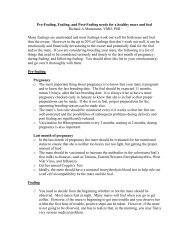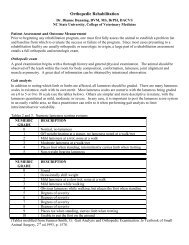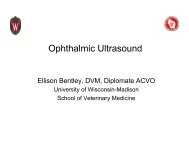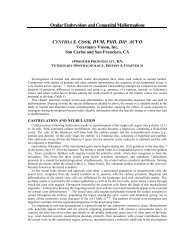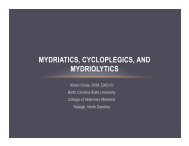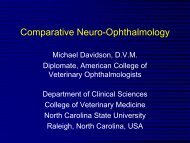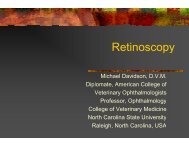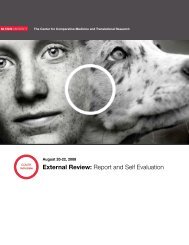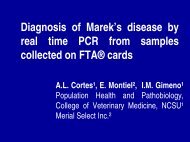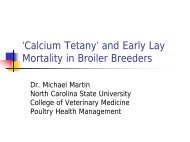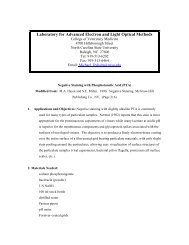Normal Histology, Part 2
Normal Histology, Part 2
Normal Histology, Part 2
You also want an ePaper? Increase the reach of your titles
YUMPU automatically turns print PDFs into web optimized ePapers that Google loves.
• Ciliary processes (pars<br />
plicata): site of AH<br />
formation; spp variable in<br />
size and number<br />
• Iridocorneal angle (ICA)<br />
• Ciliary body musculature<br />
which extends to flattened<br />
posterior zone (pars plana)<br />
Ciliary Body
Ciliary Body Processes<br />
No. Size Form<br />
Shrew Absent (ciliary roll)<br />
Carnivores 74 – 76 Moderate Thin, Finely Convoluted<br />
Cow, Horse 100, 102 Large Thick, Broadly Convoluted<br />
Birds Numerous Small – Thin, Elongated<br />
Moderate
Ciliary Process Microanatomy<br />
• Bilayered epithelium<br />
– Inner (next to posterior<br />
chamber)<br />
• Nonpigmented<br />
– Outer (next to vasculature)<br />
• Pigmented<br />
– Both cuboidal, but columnar in<br />
some instances (horse)<br />
• Capillaries and/or venules<br />
with fenestrated endothelium<br />
• Stroma<br />
– Loose c.t. between the<br />
pigmented epithelium and<br />
vasculature
Aqueous Production at Level of<br />
• Passive diffusion and<br />
ultrafiltration (via cell<br />
membrane and tight<br />
junctions)<br />
• Active formation by<br />
selective transport<br />
systems by:<br />
Carbonic anhydrase<br />
Na/K ATPase<br />
Bilayered Epithelium
• Fills the anterior and posterior<br />
chambers<br />
• Nutrient supply for lens and<br />
cornea<br />
• Waste depository<br />
• Production and removal<br />
results in IOP<br />
• Provides clear medium<br />
• Moves from posterior chamber<br />
to anterior chamber to ICA &<br />
uveoscleral pathway<br />
Aqueous Humor
Composition Greatly<br />
Differs from Plasma
• Consists of attenuating<br />
smooth muscle, some<br />
vasculature and<br />
melanocytes<br />
• Variable in width<br />
• General widest dorsally<br />
and temporally<br />
Pars Plana
Aqueous Humor Outflow and the<br />
Iridocorneal Angle (ICA)
Principal Components<br />
• Pectinate ligament (PL)<br />
• Corneoscleral trabecular<br />
meshwork CSM)<br />
• Uveoscleral trabecular<br />
meshwork (UM)<br />
• Angular aqueous plexus<br />
(AAP)<br />
Iridocorneal Angle
Iridocorneal Angle: Aqueous Outflow<br />
Principal Components<br />
• Pectinate ligament (PL):<br />
attaches iris base to<br />
fibrous tunic and keeps<br />
ICA open<br />
• Trabecular meshworks<br />
(UM and CSM): hold &<br />
filter AH<br />
• Angular aqueous plexus<br />
(AAP): drains AH<br />
Apparatus
Pectinate Ligament: best developed in large<br />
eyes with extensive cilioscleral sinuses<br />
(ungulates, pinnipeds)<br />
Cilioscleral Sinus<br />
AC<br />
Horse ,<br />
Anterior ICA, x20<br />
Hooded seal ,<br />
Anterior ICA, x10
• Corneoscleral<br />
(filtering<br />
mechanism)<br />
• Uveal (storage<br />
area for AH)<br />
Trabecular Meshwork
Angular Aqueous Plexus (AAP): Site of<br />
greatest resistance to outflow and area<br />
most responsible for IOP formation
Flow of Aqueous Humor:<br />
Conventional and Unconventional<br />
• Posterior chamber<br />
• Anterior chamber<br />
• ICA & beyond (US –<br />
uveoscleral pathway:<br />
3% in cats, 13% in<br />
rabbits and 15% in<br />
dogs)
porcine<br />
Uveoscleral Outflow: little understood component of AH<br />
dynamics among vertebrates – each species is different<br />
bovine<br />
Sedacca KK, Samuelson DA, Lewis PA. Examination of the Anterior Uveoscleral<br />
Pathway in Domestic Species. Vet. Ophthalmol. 15 (Suppl 1): 1-7, 2012<br />
equine<br />
feline
N<br />
o<br />
r<br />
m<br />
a<br />
l<br />
G<br />
l<br />
a<br />
u<br />
m<br />
o<br />
a<br />
Uveoscleral Outflow: Canine<br />
Changes Associated with Glaucoma<br />
UT<br />
tangential sagittal elastic fibers<br />
UT<br />
Samuelson DA, Birkin-Streit A. Microanatomy of the Anterior Uveoscleral Outflow<br />
Pathway in <strong>Normal</strong> and Primary Open-Angle Glaucomatous Dogs. Vet Ophthalmol 2011;<br />
13 Sep no.943, p 1-7, Epub
Aqueous Humor Dynamics<br />
• Outflow = inflow (18 – 30 mm Hg<br />
among domestic spp: exs. 16-20<br />
in the dog; 22-26 in the horse)<br />
• Production mediated by:<br />
– Na/K ATPase pump<br />
– Carbonic anhydrase<br />
– Hydrostatic pressure against<br />
osmotic pressure gradient<br />
• Facility (outflow) mediated by:<br />
– Trabecular meshwork and AAP<br />
– Ciliary body musculature<br />
– Uveoscleral pathway
Aqueous Humor Dynamics Follow A<br />
Diurnal Cycle<br />
Canine
Ciliary Body Musclature
• Aqueous humor outflow<br />
• Lenticular<br />
accommodation<br />
Functions of the CBM
Effectiveness among domestic species: moderate<br />
in carnivores, weak in herbivores
Ciliary Body Musculature and Its<br />
Development Among Mammals<br />
Carnivore<br />
Primate<br />
Herbivore
Anterior portion of the CBM forms<br />
tendinous endings to the TM and<br />
facilitates AH Removal
Other paradigms of CBM exists within each major<br />
mammalian group (carnivores, ungulates, rodents,<br />
etc), each functioning to provide optimal ocular<br />
refraction via changes in lens or globe shape and<br />
position.<br />
squirrel<br />
pig<br />
mongoose
Lenticular Accommodation<br />
Contracted<br />
Relaxed
• Ciliary body (CB) has little to no<br />
musculature that will provide for lens<br />
accommodation.<br />
• Anterior CB and ICA possess<br />
encapsulated corpuscles (EC),<br />
believed to be pressure detectors,<br />
which could detect changes in<br />
intraocular pressure (IOP).<br />
• Postulated that changes in eye shape<br />
will result in shifting the lens axially,<br />
i.e., lenticular accommodation and<br />
cause changes in IOP detected by<br />
ECs.<br />
• IOP changes could result from<br />
combination of eyelids’ muscles and<br />
retractor bulbi muscle activity.<br />
Aquatic condition<br />
Bowhead whale;<br />
Zhu et al, Mar Mam Sci<br />
17:729, 2001<br />
encapsulated corpuscle EC<br />
within posterior ICA of pilot whale<br />
- S. Miles, UF
Ex. baleen whales
• Variable ocular<br />
refraction is<br />
performed through a<br />
combination of<br />
extensive intraocular<br />
muscles, including<br />
iridal muscles, a<br />
strong scleral<br />
baseplate and a very<br />
pliable lens.<br />
• Muscles are skeletal<br />
and may be used in<br />
an uniocular manner.<br />
Avian condition<br />
Great Horned Owl
Summary<br />
• Ciliary body functions primarily to produce and<br />
remove aqueous humor, resulting in specific IOPs<br />
• Possesses variably developed ciliary processes<br />
and iridocorneal angles for AH dynamics<br />
• Possesses variably developed musculature,<br />
smooth in mammals, skeletal in non-mammals, for<br />
lenticular accommodation and facilitation of AH<br />
removal, or just facilitation of AH removal



